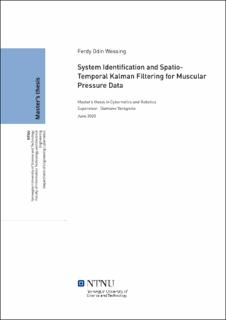| dc.contributor.advisor | Varagnolo, Damiano | |
| dc.contributor.author | Wessing, Ferdy Odin | |
| dc.date.accessioned | 2021-09-23T18:13:05Z | |
| dc.date.available | 2021-09-23T18:13:05Z | |
| dc.date.issued | 2020 | |
| dc.identifier | no.ntnu:inspera:56990118:20915771 | |
| dc.identifier.uri | https://hdl.handle.net/11250/2780957 | |
| dc.description.abstract | Denne masteroppgaven er et første skritt mot å oppnå ett glattet estimat av trykket som skapes av bekkenbunnsmuskulaturen. Metoden som presenteres kan deles inn i to skritt. Først gjøres system identifikasjon for å finne en polynomisk modell av systemets dynamikk. Signalene fra hjernen som styrer musklene approksimeres som et binært inngangssignal ved hjelp av en change detection algoritme. Dette inngangssignalet må tidsskiftes tilbake i tid, slik at inngangssignalet eksiteres før trykket. Trykkdataen som er samlet av FemFit, en vaginal trykksensor, kombineres med det estimerte inngangssignalet for å finne en diskret-tids ARX modell for hver av de 8 sensorene som FemFit består av. Dette gjøres ved å anta at hver av trykkmålingene har samme fordeling, med unntak av en skaleringsfaktor på inngangssignalet. Skaleringsfaktoren, ARX parametrene og tidsskiftet optimeres samtidig for ARX modeller med forskjellig orden. Alle de evaluerte ARX modellene oppnådde et simulerings-fit på omtrent 45% på valideringsdata, noe som indikerer at nøyaktigheten begrenses av den simple estimeringen av inngangssignalet. Den enkleste modellen, ARX211, konverteres til en tilstandsromrepresentasjon. Tilstandsromrepresentasjonen brukes i det andre skrittet til gaussisk regresjon i tid og rom ved hjelp av et Kalman filter. Kalman filteret er tilpasset fra artikkelen "Efficient Spatio-Temporal Gaussian Regression via Kalman Filtering" av Todesca et al. (2020) for bruk med muskeltrykk som data. I motsetning til den originale algoritmen, blir et system funnet i diskret-tid direkte. På grunn av dette må den initielle kovariansen estimeres, og støy kovariansene må stilles inn. Verdier for kovariansene som modellerer dynamikken tilstrekkelig ble ikke funnet, men den glattende egenskapen -- som glatter ut støy -- blir presentert. Til slutt blir noen forbedringer foreslått som fremtidig arbeid, og noen potensielle bruksområder nevnes. | |
| dc.description.abstract | This thesis serves as an initial step towards smoothed estimation of the pressure caused by the pelvic floor muscles. The method used to achieve the smoothing can be divided into two steps. First, system identification is done to create a polynomial model of the dynamics. This is done by approximating the brain signals which control the muscles as a binary input with a change detection algorithm. This input must be time-shifted back in time to occur before the excitation in the pressure. The collected pressure data from the FemFit vaginal pressure sensor is combined with this input to create a discrete-time ARX model for each of the 8 sensors of the FemFit. This is done by assuming that each of the pressures measured have the same distribution, but with a scaling factor on the input. The scaling factors, ARX parameters and time-shifts are jointly optimized for different orders of ARX models. All the ARX models achieve a simulation fit of approximately 45% on the validation set, indicating that they are likely limited by the simple input estimation. The simplest model, the ARX211, is converted into a state space model. This state space model is used in the second step for spatio-temporal gaussian regression using a Kalman filter. This Kalman filter is adapted, for the purpose of muscular pressure data, from the paper Efficient Spatio-Temporal Gaussian Regression via Kalman Filtering by Todesca et al. (2020). As opposed to the original paper, the method in this thesis arrives directly at a discrete-time model. Because of this, the initial covariance of the Kalman filter must be estimated, and the noise covariances must be tuned. A tuning which adequately models the dynamics was not found, but the smoothing properties of the method are presented. Some improvements are suggested in future work, together with some possible applications of the method. | |
| dc.language | | |
| dc.publisher | NTNU | |
| dc.title | System Identification and Spatio-Temporal Kalman Filtering for Muscular Pressure Data | |
| dc.type | Master thesis | |
